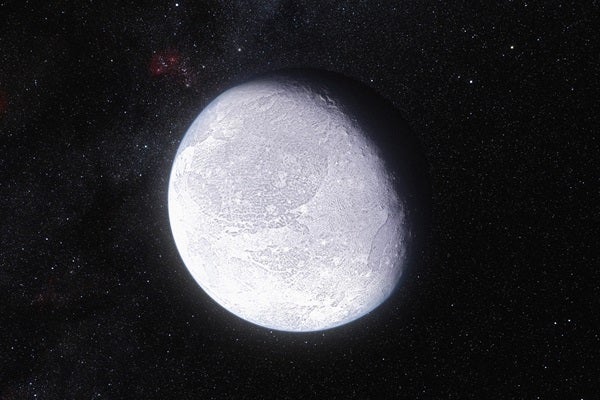
Two nearly-identically sized worlds — Eris and Pluto — float distantly in the same frozen region of our outer solar system. A NASA spacecraft has visited Pluto, but not Eris, and each is so distant that it’s hard to study by telescope.
So, if astronomers want to find out if what’s inside a distant solar system body, what can they do? Thankfully, as a new paper published in Science Advances demonstrates, you can use their moons to do so.
Well past the giant planets, a region of frozen bodies slowly orbits the Sun in what’s known as the Kuiper Belt. In this region, Eris and Pluto tower in size above all others. The former is just 30 miles smaller in diameter than the latter, and the next largest object, Makemake, is smaller by more than 500 miles. Eris’s close size to Pluto factored into the reassignment of Pluto into a dwarf planet.
The moons of Eris and Pluto
You’d be reasonable to assume the two bodies are similar in composition too. But even to the eyes of the Webb Space Telescope, they’re mere specks of light. The moons of both offer a key to understanding. Pluto’s largest moon, Charon, is so large relative to Pluto that the two orbit a mutual point in space. Eris’s sole known moon, Dysnomia, doesn’t quite compare size-wise. It’s about half the size of Charon, which is about half the size of Pluto.
But Dysnomia’s size is large enough to exert a significant influence on its parent body, Eris. Francis Nimmo, a planetary scientist at the University of California-Santa Cruz, says that just as Earth’s Moon slowed down our planet’s early rotation rate, the same thing happened with Eris, such that Dysnomia is now tidally locked with Eris. That means the moon’s side always faces Eris, and the same side of Eris also, unusually, faces the Moon.
Planetary scientists are interested in the orbital relationships between Eris and Dysnomia. “Dysnomia is pretty small,” says Nimmo. “It’s a fairly wimpy moon. And so in order for it to have spun Eris down, it turns out that Eris must have been pretty squishy. And we have a way of measuring the squishiness of Eris basically.”
Analysis of the two orbits reveals that if Eris consisted of mixed icy and rocky areas, its density would be higher than what they observe. It would be insufficiently squishy. But if a clean boundary existed between a rocky core and an icy mantle, and the mantle was once relatively warm, “then you can get Eris to be squishy enough,” Nimmo says.
Eris has a layer of ice
This also means that, close to the rocky core, Eris contains a warm layer of convecting ice, continuing the body on its squishy legacy. And that warm layer may stay oddly on the move. This model also shows that Eris contains much more rock than Pluto.
“We think that the ice shell on Eris is slowly moving around, whereas as far as we can tell, the ice shell on Pluto isn’t moving at all. It’s completely stagnant,” Nimmo says. “And beneath the ice shell on Pluto, we think there’s probably a liquid water ocean.”
The icy shell takes a lot of the heat from the core and dissipates it up the icy shell as it moves, meaning none is really melting the ice. (A separate commentary in Science Advances suggests that perhaps there is an ocean on Eris, just a much different one than Pluto’s.)
Charon and Dysnomia also have a tale to tell about why their parent bodies are so different. Nimmo says each likely formed from large impacts slamming into their parent bodies. Whatever formed Dysnomia was moving faster when it hit, breaking a large chunk off, whereas Charon may have had a slower, more substantial impactor like the one that formed our Moon.
JWST’s role
Understanding the interiors of other Kuiper Belt objects might prove more difficult. While a few are known to have moons, most don’t have the same kind of size dynamic as Pluto and Charon or Eris and Dysnomia. “It’s certainly worth thinking about, but you have to get lucky that the moon has to be big enough that it can actually de-spin the planet at all, but it can’t be so big that de-spinning doesn’t tell you anything about how squishy the planet is,” Nimmo says.
But JWST could help us suss out some things about the interiors. Pluto’s hard ice shell is covered in varying topographies, with cliffs and mountains and more surface features. By contrast, Eris seems to be pretty smooth. Other “smooth” bodies without large surface features could mean that they’re comparatively squishy.
As for finding whether they have oceans like Pluto, or perhaps small oceans like Eris, it’s more of a crapshoot.
“I think the lesson from Pluto is that even out there, oceans are things we should be thinking seriously about,” Nimmo says. “And I think the lesson from Eris is that oceans aren’t guaranteed.”









